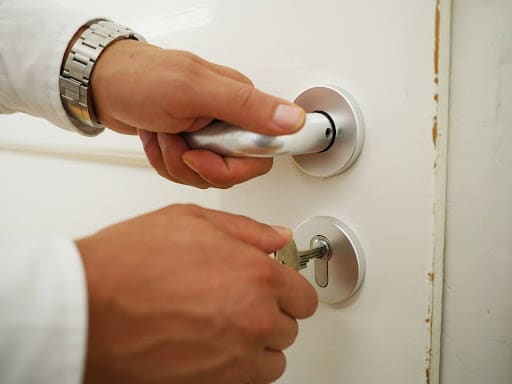Have you ever encountered the frustration of a door lock that refuses to turn? We understand how exasperating this situation can be. That’s why we’ve put together this comprehensive guide to help you unlock the mystery of a door lock that won’t budge. In this article, we will explore the common reasons behind this issue, the tools you’ll need for the job, and provide you with a step-by-step guide to fix it. Additionally, we will share troubleshooting tips, advice on when to call a professional locksmith, and preventative measures to avoid future lock issues. So, let’s delve into the world of door lock repair and restore functionality to your door lock.
Understanding the Common Reasons Behind a Door Lock That Won’t Turn
Before we dive into the solutions, it’s crucial to understand the common reasons why a door lock may refuse to turn. One of the primary culprits is a misaligned strike plate. Over time, the strike plate can become loose or shift, preventing the lock’s bolt from properly aligning with the strike plate hole. Another potential cause is a worn-out key or cylinder. If your key shows signs of wear and tear, it might be time to replace it. Additionally, a lack of lubrication can impede the smooth movement of the lock’s internal components, making it difficult to turn. Identifying the underlying cause is essential for effective troubleshooting and repair.
Tools You’ll Need to Fix a Door Lock That Won’t Turn
To fix a door lock that refuses to turn, you’ll need a few essential tools. Having these tools at hand will make the repair process smoother and more efficient. Here’s a list of the tools you should gather:
- Screwdriver set: A set of screwdrivers will come in handy for removing screws and disassembling the lock.
- Lubricant: Choose a lubricant specifically designed for lock mechanisms to ensure smooth functionality.
- Replacement parts: Depending on the issue, you may need to replace certain components of the lock, such as the strike plate or key.
- Pliers: Pliers will assist in gripping and maneuvering small parts during the repair process.
- Wire brush: Use a wire brush to clean any debris or rust that may be hindering the lock’s movement.
With these tools in your arsenal, you’ll be well-prepared to tackle the task of fixing your stubborn door lock.
Step-by-Step Guide to Fixing a Door Lock That Won’t Turn
Now that you have a grasp of the common causes and the tools required, let’s delve into the step-by-step process of fixing a door lock that won’t turn. Remember to approach each step with patience and caution to avoid causing further damage.
Inspect the strike plate
Begin by examining the strike plate to ensure it is aligned properly. If it appears misaligned, use a screwdriver to loosen the screws and adjust the plate until it aligns with the lock’s bolt. Tighten the screws once the alignment is correct.
Lubricate the lock
Apply a small amount of lubricant to the lock’s keyway and internal components. Use the key to work the lubricant into the lock, ensuring all moving parts are well-coated. This should help resolve any friction-related issues.
Examine the key
Inspect your key for signs of wear or damage. If necessary, have a duplicate made using the original key or consider replacing the key altogether. Using a worn-out key can exacerbate the problem and potentially damage the lock further.
Clean the lock mechanism
If the lock is still not turning smoothly, use a wire brush to remove any dirt, debris, or rust from the lock mechanism. Ensure that all parts are thoroughly cleaned before reassembling the lock.
Reassemble the lock
Carefully reassemble the lock, following the reverse order of disassembly. Make sure all components fit snugly and are aligned correctly.
By following these steps, you should be able to restore functionality to your door lock and regain peace of mind.
Additional Troubleshooting Tips for Stubborn Door Locks
In some cases, the steps outlined above may not resolve the issue with your door lock. If you find yourself at a loss, here are a few additional troubleshooting tips to consider:
- Check the door alignment: A misaligned door can put unnecessary pressure on the lock, making it difficult to turn. Make sure the door and frame are lined up correctly.
- Evaluate the latch bolt: The latch bolt is the part of the lock that extends into the strike plate. If the latch bolt does not fully extend or retract, it may need adjustment or replacement.
- Consider the lock’s age and condition: If your lock is old or severely damaged, it might be more cost-effective to replace it entirely rather than attempt repairs. Consult with a professional locksmith for guidance in this situation.
Remember, if your attempts at troubleshooting and repair are unsuccessful, it’s important to know when to call a professional locksmith for assistance. They have the expertise and specialized tools to handle complex lock issues safely and efficiently.
Preventative Measures to Avoid Future Door Lock Issues
Now that you have successfully fixed your door lock, it’s essential to take preventative measures to avoid future problems. Here are some tips to keep your lock in optimal condition:
- Maintain regular lubrication: Periodically apply a lock-specific lubricant to ensure smooth operation. This will help prevent friction-related issues that can cause the lock to seize up.
- Keep keys in good condition: Avoid bending or forcing keys into the lock. If a key becomes difficult to insert or turn, have a replacement made promptly to prevent further damage.
- Protect your lock from the elements: If your lock is exposed to harsh weather conditions, consider installing a cover or using a weatherproof sealant to protect it from moisture and corrosion.
By implementing these preventative measures, you can extend the lifespan of your door lock and minimize the chances of encountering future problems.
Maintaining Your Door Lock for Optimal Performance
Regular maintenance is key to ensuring your door lock operates smoothly and reliably. Here are a few maintenance tasks you can perform to keep your lock in optimal condition:
- Clean the lock regularly: Use a soft cloth to wipe down the lock’s exterior and remove any dust or debris that may have accumulated.
- Inspect for loose screws: Periodically check the lock for loose screws and tighten them if necessary. Loose screws can cause misalignment and hinder the lock’s functionality.
- Test your lock periodically: Regularly test your lock to ensure it turns smoothly and without any resistance. Take quick action to resolve any problems you see before they get worse.
By incorporating these maintenance tasks into your routine, you can proactively address any potential issues and maintain the optimal performance of your door lock.
Recommended Products for Fixing a Door Lock That Won’t Turn
While the tools mentioned earlier are essential for door lock repair, there are a few recommended products that can further enhance your repair process:
- Lock lubricant: Invest in a high-quality lock lubricant, such as graphite powder or a silicone-based lubricant, to ensure smooth operation and long-term protection for your lock.
- Key extraction kit: If your key becomes stuck or breaks off in the lock, a key extraction kit can be invaluable in safely removing the key without causing damage.
- Strike plate reinforcement: Consider installing a strike plate reinforcement plate to fortify the security of your door lock. These plates provide added strength and prevent the strike plate from becoming loose or damaged.
By utilizing these recommended products, you can enhance the effectiveness of your repair efforts and maintain the longevity of your door lock.
Conclusion
Dealing with a door lock that won’t turn can be a frustrating experience. However, armed with the knowledge and guidance provided in this article, you are well-equipped to tackle this challenge head-on. By understanding the common reasons behind this issue, having the necessary tools at hand, and following our step-by-step guide, you can restore functionality to your door lock and enjoy peace of mind. Always remember to maintain your equipment regularly, take preventative action, and get expert assistance when necessary. With these practices in place, you can ensure your door lock remains in optimal condition for years to come. So, don’t let a stubborn lock keep you out or compromise your security – take action today and unlock the mystery of a door lock that won’t turn.
Frequently Asked Questions
1. Can I fix a door lock that won’t turn without any prior experience?
Yes, many door lock issues can be resolved with DIY repairs. However, it’s important to assess the severity of the problem and know your limits. If you’re unsure or uncomfortable with the repair process, it’s best to consult a professional locksmith.
2. How often should I lubricate my door locks?
It’s recommended to lubricate your door locks at least once a year. However, if you notice any signs of stiffness or difficulty turning the key, lubrication may be necessary sooner.
3. Can I use any type of lubricant on my door locks?
It’s best to use a silicone-based lubricant or graphite powder specifically designed for locks. These lubricants are less likely to attract dirt and debris, ensuring long-term smooth operation.
4. What should I do if the lock is still stuck after attempting repairs?
If the lock remains stuck or the problem persists, it’s advisable to call a professional locksmith. They have the expertise and specialized tools to handle more complex lock issues.
5. Are there any preventive measures I can take to avoid door lock problems?
Regularly cleaning and lubricating your locks, avoiding excessive force when turning the key, and addressing any signs of wear or damage promptly can help prevent door lock problems.
6. Can I use WD-40 as a lubricant for my door locks?
While WD-40 can provide temporary relief, it is not recommended as a long-term lubricant for door locks. It tends to attract dust and debris, which can eventually cause more harm than good. Instead, opt for a lubricant specifically designed for locks.
7. Can I repair a door lock myself, or should I hire a professional locksmith?
Simple issues like misaligned strike plates or lack of lubrication can often be resolved by a homeowner. However, if you are unsure or encounter more complex problems, it is best to seek the assistance of a professional locksmith to avoid causing further damage.
8. How long does it take to fix a door lock?
The time required to fix a door lock depends on the complexity of the issue and your level of experience. Simple repairs can often be completed within an hour, while more intricate problems may take longer.


